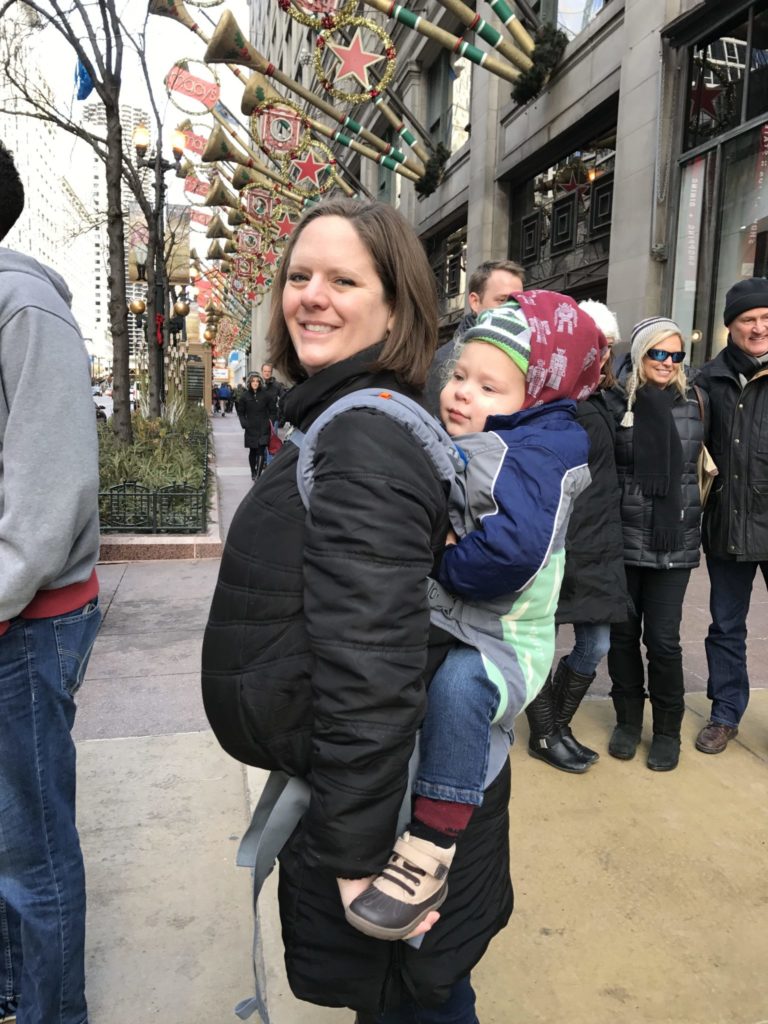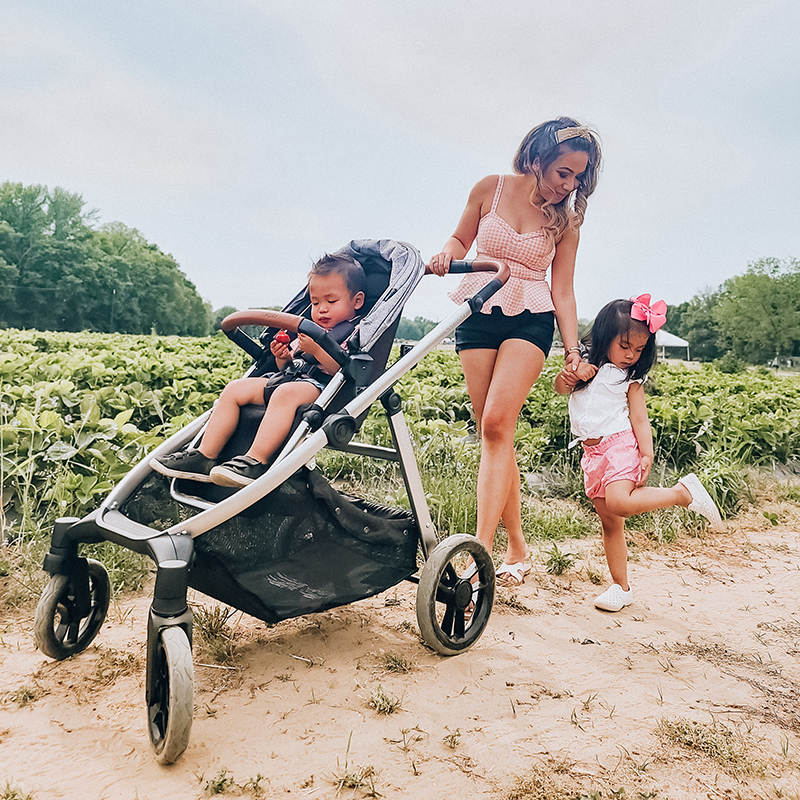 Living in Chicago means the summer months are full of questions about babywearing in the heat and come October, the babywearing in the winter questions start flying! The good news is that there are are a variety of options to keep you and your baby warm in the winter. The fall and winter are full of fun outdoor activities. A caregiver and child can participate in these activities and stay warm at the same time using the strategies listed below. For my family, some activities such as being downtown for the day, seeing Zoo Lights, or picking out a Christmas tree are more manageable and fun when we use babywearing as a tool.
Living in Chicago means the summer months are full of questions about babywearing in the heat and come October, the babywearing in the winter questions start flying! The good news is that there are are a variety of options to keep you and your baby warm in the winter. The fall and winter are full of fun outdoor activities. A caregiver and child can participate in these activities and stay warm at the same time using the strategies listed below. For my family, some activities such as being downtown for the day, seeing Zoo Lights, or picking out a Christmas tree are more manageable and fun when we use babywearing as a tool.
Caregivers (and especially grandparents) are often concerned about babies being warm enough. Remember, being cold can’t make you sick! The general rule of thumb is that a baby should be dressed in one more layer than an adult in order to be comfortable. Any layer of clothing (including a onesie), a blanket, or fleece all count as a layer. In addition, a baby carrier itself counts as a layer over the torso. Babywearing during the winter allows a caregiver to complete day-to-day activities with ease and comfort!
Under or Over:
When babywearing in the winter, you can wear your carrier under your jacket or over it.
Under
If you wear your carrier under your jacket, you and your child will benefit from the combined body heat. Your child may not need to wear a jacket (depending on the fit and if your child prefers to be arms in or arms out). To wear your carrier under a jacket, there are a couple options including special coats, inserts, and DIY options. Listed below is more information about all of these options.
Over
You can also both wear appropriate attire for the weather and wear the carrier over your jacket. The benefit is that you do not need any special accessories. The downside is that it can be very slippery and cumbersome to put a child in a carrier with you both wearing heavy coats. I suggest asking for help from another adult.
Jackets:
Babywearing Coats
There are a variety of babywearing hoodies and coats. A dedicated babywearing coat can be a worthy investment for a caregiver who wears often throughout winter months. There are also babywearing hoodies that can meet your needs during fall weather. Babywearing coats come in a variety of styles with a plethora of features. These features include front/hip/back wearing, hood options, tandem wearing, various coldness ratings, style, ease of use, etc. You can find something that meets your needs as well as your style. A child being worn completely under the coat with an adult may not need his/her own coat. The one extra layer should be enough if the child is completely covered (except for the face) by the coat. For a child who wants to be arms out, the upper body may not be covered by the coat so a warm enough jacket and hand coverings will be necessary.
DIY
There are a couple DIY options that caregivers can use to wear in the winter on a budget. Some caregivers like to use a coat that is a size up for front wearing. You can zip the coat around you and the child and zip over the child’s back. Another option is to put a larger hoodie on the caregiver backward. The hood becomes a hood for the baby. The caregiver can put the adult coat on the typical way so both bodies stay warm.
Warning
There are inexpensive knock-off versions of babywearing hoodies all over the internet. A babywearing hoodie or coat should be made to go over the carrier. It should not have a “pouch” to put the baby in. If you find yourself in possession of one of these versions, you can often modify it by cutting out the piece of fabric that comes between the adult and the child.
Accessories:
Inserts:
Inserts made to zip into your own coat are available for a less expensive option to turn a regular coat into a babywearing coat. They zip into either side of the adult coat. They can serve as a maternity panel extender and a babywearing extender. These inserts can also come with a hood for the child.
Covers:
For those less frigid days, there are covers that can be attached to the carrier to provide an extra layer for the child. They come in a variety of weights from thin jersey to thick wool. Carrier covers often attach to themselves and over the carrier using snaps or velcro. They can be a dedicated carrier cover or also serve as a stroller cover. Even easier than a special carrier cover is tucking a blanket around the carrier, which can be quick and easy. The blanket serves as an extra layer to keep a young child warm.
Dressing Baby:
Head:
In order to keep the child’s head warm you can use a hood on a shirt the child is wearing, use a hood on a coat/carrier cover, and/or put a hat on the child. I recommend having both options available because young children often have preferences and may not readily go along with yours!
Legs:
Just like when an adult sits down, our pants rise when a child sits in a carrier, there can be a gap between their socks and pants. In the winter, ensure you cover bare skin so your baby isn’t exposed to the elements. Accomplish this with knee- or thigh-high socks, extra long pants, leg warmers, or booties that come up to the calves or higher.
So now what?
There are a variety of options to keep you and your child warm from early fall through frigid winter days. Figure out what your budget, style, and needs dictate, and look into the option that meets all three. With any of these options, it is important to remember that a child’s airway should always be clear. The caregiver should be able to monitor a child’s breathing at all times and fabric should not cover the child’s face (don’t zip up a coat over the baby’s head!).
Living in Chicago means the summer months are full of questions about babywearing in the heat and come October, the babywearing in the winter questions start flying! The good news is that there are are a variety of options to keep you and your baby warm in the winter. The fall and winter are full of fun outdoor activities. A caregiver and child can participate in these activities and stay warm at the same time using the strategies listed below. For my family, some activities such as being downtown for the day, seeing Zoo Lights, or picking out a Christmas tree are more manageable and fun when we use babywearing as a tool.
Caregivers (and especially grandparents) are often concerned about babies being warm enough. Remember, being cold can’t make you sick! The general rule of thumb is that a baby should be dressed in one more layer than an adult in order to be comfortable. Any layer of clothing (including a onesie), a blanket, or fleece all count as a layer. In addition, a baby carrier itself counts as a layer over the torso. Babywearing during the winter allows a caregiver to complete day-to-day activities with ease and comfort!
Under or Over:
When babywearing in the winter, you can wear your carrier under your jacket or over it.
Under
If you wear your carrier under your jacket, you and your child will benefit from the combined body heat. Your child may not need to wear a jacket (depending on the fit and if your child prefers to be arms in or arms out). To wear your carrier under a jacket, there are a couple options including special coats, inserts, and DIY options. Listed below is more information about all of these options.
Over
You can also both wear appropriate attire for the weather and wear the carrier over your jacket. The benefit is that you do not need any special accessories. The downside is that it can be very slippery and cumbersome to put a child in a carrier with you both wearing heavy coats. I suggest asking for help from another adult.
Jackets:
Babywearing Coats
There are a variety of babywearing hoodies and coats. A dedicated babywearing coat can be a worthy investment for a caregiver who wears often throughout winter months. There are also babywearing hoodies that can meet your needs during fall weather. Babywearing coats come in a variety of styles with a plethora of features. These features include front/hip/back wearing, hood options, tandem wearing, various coldness ratings, style, ease of use, etc. You can find something that meets your needs as well as your style. A child being worn completely under the coat with an adult may not need his/her own coat. The one extra layer should be enough if the child is completely covered (except for the face) by the coat. For a child who wants to be arms out, the upper body may not be covered by the coat so a warm enough jacket and hand coverings will be necessary.
DIY
There are a couple DIY options that caregivers can use to wear in the winter on a budget. Some caregivers like to use a coat that is a size up for front wearing. You can zip the coat around you and the child and zip over the child’s back. Another option is to put a larger hoodie on the caregiver backward. The hood becomes a hood for the baby. The caregiver can put the adult coat on the typical way so both bodies stay warm.
Warning
There are inexpensive knock-off versions of babywearing hoodies all over the internet. A babywearing hoodie or coat should be made to go over the carrier. It should not have a “pouch” to put the baby in. If you find yourself in possession of one of these versions, you can often modify it by cutting out the piece of fabric that comes between the adult and the child.
Accessories:
Inserts:
Inserts made to zip into your own coat are available for a less expensive option to turn a regular coat into a babywearing coat. They zip into either side of the adult coat. They can serve as a maternity panel extender and a babywearing extender. These inserts can also come with a hood for the child.
Covers:
For those less frigid days, there are covers that can be attached to the carrier to provide an extra layer for the child. They come in a variety of weights from thin jersey to thick wool. Carrier covers often attach to themselves and over the carrier using snaps or velcro. They can be a dedicated carrier cover or also serve as a stroller cover. Even easier than a special carrier cover is tucking a blanket around the carrier, which can be quick and easy. The blanket serves as an extra layer to keep a young child warm.
Dressing Baby:
Head:
In order to keep the child’s head warm you can use a hood on a shirt the child is wearing, use a hood on a coat/carrier cover, and/or put a hat on the child. I recommend having both options available because young children often have preferences and may not readily go along with yours!
Legs:
Just like when an adult sits down, our pants rise when a child sits in a carrier, there can be a gap between their socks and pants. In the winter, ensure you cover bare skin so your baby isn’t exposed to the elements. Accomplish this with knee- or thigh-high socks, extra long pants, leg warmers, or booties that come up to the calves or higher.
So now what?
There are a variety of options to keep you and your child warm from early fall through frigid winter days. Figure out what your budget, style, and needs dictate, and look into the option that meets all three. With any of these options, it is important to remember that a child’s airway should always be clear. The caregiver should be able to monitor a child’s breathing at all times and fabric should not cover the child’s face (don’t zip up a coat over the baby’s head!).
Stephanie Hopkins is a contributing writer who is a Center for Babywearing Studies graduate. Follow her story at redbarnbasics.com.


